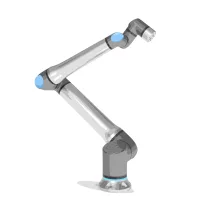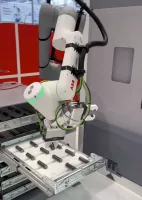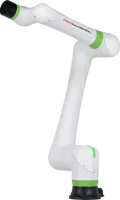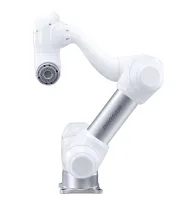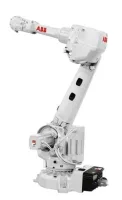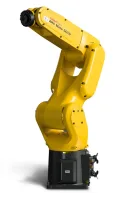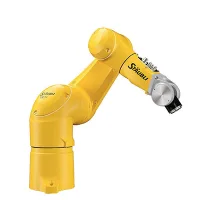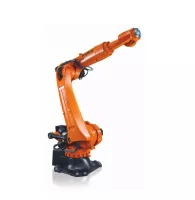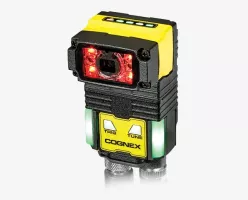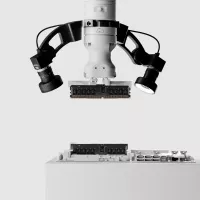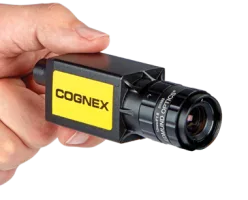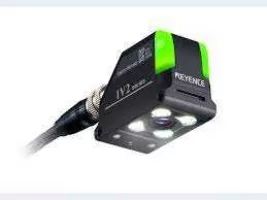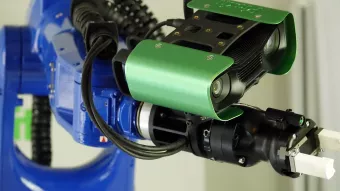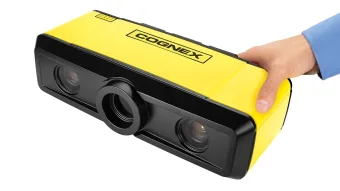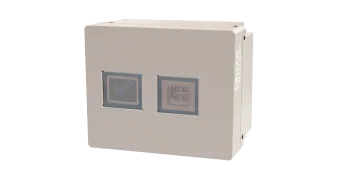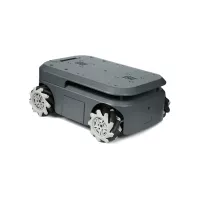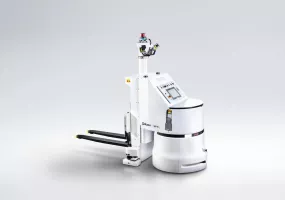THE POWER OF END OF LINE AUTOMATION
See how final steps in making products get faster and safer with smart machines.
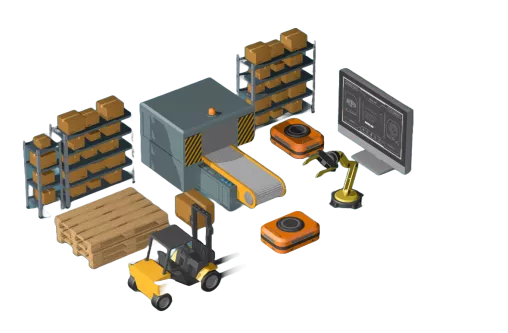
END OF LINE AUTOMATION MARKET (2023)
FOOD AND BEVERAGE
REDUCE WASTE BY
1. What is End of Line Automation in Manufacturing?
End of Line (EoL) automation is the final step in making products before they go out to stores or customers. Think of it as the finish line in manufacturing where everything the product needs to be ready for sale happens. This includes putting products into boxes, sealing them, labeling, and making sure they're all good to go. It's like the packaging and final check-up phase for products.
For you, EoL automation means using machines and robots to do these last steps. Instead of people doing all the work by hand, which can take a lot of time and sometimes lead to mistakes, these smart machines take over. They can pack things faster and check that everything is perfect in a way that's always the same, making sure customers get what they're expecting. Plus, it helps get products out the door quicker, so they reach shelves or your home without delay.

2. Why is End of Line Automation Important?
End of Line automation is crucial because it makes the final steps of manufacturing much smoother and faster. Imagine the last part of making a product, like packing and checking it, being super efficient. That's what EoL automation does. It uses machines to pack, label, and get products ready to be sent out. This means products are finished quicker and with fewer mistakes, ensuring you get what you ordered just right.
For businesses, EoL automation is a game-changer. It cuts down on the time and money spent on these last steps, making the whole manufacturing process cheaper and faster. Plus, it helps make sure every product meets high-quality standards before it reaches you. In short, EoL automation is all about getting products to you faster, in perfect condition, and at the best price.
3. Why You Need End of Line Automation:
Increased Efficiency
End of line (EOL) automation streamlines your production process, significantly boosting output. By automating tasks like packaging and sorting, machines work faster and more consistently than human labor, reducing bottlenecks and increasing your throughput.
Cost Savings
Investing in EOL automation may seem pricey upfront, but the long-term savings are substantial. Automation cuts labor costs and minimizes errors, leading to less waste and more productivity. Over time, these savings add up, improving your bottom line.
Quality and Consistency
Automation ensures each product is handled and packaged in the exact same way, maintaining high quality across your output. This consistency helps in building trust with your customers, as they receive products that meet their expectations every time.
Adapting to Demand
With EOL automation, scaling up production in response to market demands becomes smoother and quicker. This flexibility allows you to keep up with customer needs without sacrificing quality or efficiency.
4. What Processes are Automated at the End of Line?
At the End of Line in manufacturing, several key processes get a high-tech upgrade to make sure products are ready to go out to customers like you. Here's what gets automated:
Packing:
Machines carefully put products into boxes or packaging, making sure they're safe and secure for their journey to you.
Labeling:
Automated systems stick labels on the packaging, so you know what the product is, how to use it, and where it comes from.
Quality Checking:
Before anything leaves the factory, special cameras and sensors check each product. They make sure everything looks right and works as it should, so you don't end up with something that's not up to par.
Palletizing:
Finally, robots stack the packaged products on pallets, getting them ready for shipment. This means your items can be shipped off quickly and efficiently, arriving at stores or your doorstep in no time
Featured End of Line Cobots:
5. Can EoL Automation be Customized for Specific Products?
Yes, End of Line automation can be specially tailored to fit specific products. Imagine having a machine that's designed just for what you're making, whether it's toys, electronics, or snacks. This customization means that no matter the size, shape, or type of your product, the automation system can handle it perfectly.
For you, this means the packaging and final checks are done just right for your product. If you're making something fragile, the system can be set to handle it gently. If your products are unique in shape, the packaging equipment can adjust to fit them snugly. This flexibility ensures your products are well taken care of, looking good, and ready to impress customers. In short, customizing EoL automation helps make sure your products leave the production line looking their best, tailored exactly to their needs.
Featured End of Line Industrial Robots
6. What Technologies are Used in End of Line Automation?
In End of Line automation, several cool technologies work together to get your products ready to go out the door. Here's a quick look at what's involved:
Robotic Arms:
These are like the hands of the system. They pick up products, place them into packaging, or stack them onto pallets. It's all done with precision and speed.
Conveyor Belts:
Think of these as the moving sidewalks of the factory. They carry products from one station to another, making sure everything keeps moving smoothly.
Vision Systems:
These are the eyes. They check products for any defects and make sure everything looks just right before it's packed. It's like having a quality control expert watching over every step.
Labeling Machines:
Just as it sounds, these machines put labels on your products quickly and accurately.
Wrapping Machines:
Finally, these machines wrap up your products or pallets, making sure they're secure and ready for shipping.
Together, these technologies make EoL automation a crucial part of getting products to you quickly and in perfect condition.
7. How Does Quality Inspection Work in End of Line Automation?
In End of Line automation, quality inspection is like the final check-up before products head out to you. Here's how it works:
Seeing Everything:
Vision systems, which are basically cameras with super-smart software, look at each product. They check for any mistakes, like wrong labels or damaged packaging, making sure only the best products make it through.
Making Decisions:
These systems aren't just looking; they're thinking too. If they spot something off, they can decide to remove the product from the line. It's like having a super-observant inspector who never misses a detail.
Quick Fixes:
Sometimes, if a small issue is found, the system can even fix it on the spot, like adjusting a label. This means fewer delays and faster shipping for you.
Quality inspection in EoL automation ensures that what you get is exactly what you're expecting, in perfect condition, every time.
Featured End of Line 2D Vision Systems:
8. What are the Challenges of Implementing End of Line Automation?
Implementing End of Line automation can be a bit tricky, and here's why:
Upfront Costs:
Setting up EoL automation means spending some money at the start. It's like buying a high-tech gadget; it costs more upfront, but it's worth it for the benefits you get.
Fitting It In:
Imagine trying to add a new app to your phone, but it's not quite compatible. Similarly, getting new EoL automation to work smoothly with your existing setup can be challenging. You have to make sure everything talks to each other correctly.
Learning Curve:
Just like learning to use a new smartphone, your team needs to learn how to operate and maintain these automated systems. This means training, which takes time and patience.
Job Changes:
As machines take over some tasks, the roles of people in the factory will change. It's important to manage this transition carefully to keep everyone on board and moving forward together.
While these challenges might seem daunting, overcoming them can lead to a more efficient, productive, and safer production line.
9. How Does End of Line Automation Improve Product Safety?
End of Line automation makes products safer for you in a couple of key ways:
Less Touching:
Since machines do most of the work, like packing and sealing, there are fewer hands touching your products. This reduces the risk of contamination and makes things like food and medicines safer for you.
Perfect Packing:
The automated systems are really good at packing products just right. This means your items are well-protected during shipping, so they're less likely to get damaged on the way to you.
EoL automation helps ensure that the products you use every day are safe and arrive in the best condition.
Featured End of Line 3D Vision Systems:
10. Can Small and Medium Enterprises (SMEs) Benefit from End of Line Automation?
Absolutely, Small and Medium Enterprises (SMEs) can greatly benefit from End of Line (EoL) automation. Think of it like upgrading your kitchen with the latest gadgets; suddenly, you can cook faster, cleaner, and with less effort. For SMEs, EoL automation does something similar for production lines.
Efficiency Boost:
Even with smaller operations, automation speeds up the final steps of packaging and quality checks. This means you can get your products out faster without hiring a lot of extra hands.
Cost Savings:
Over time, the investment in automation pays off. You spend less on labor and reduce waste, thanks to more precise packaging and fewer errors.
Quality and Consistency:
EoL automation ensures every product meets your high standards, giving your customers the quality they expect every time.
So, yes, SMEs stand to gain a lot from adopting EoL automation, making their operations more efficient, cost-effective, and competitive.
11. How Flexible is End of Line Automation for Product Changes?
End of Line automation is surprisingly flexible when it comes to changing products. Imagine you're playing a video game and you switch from one level to the next with different challenges; EoL automation can switch gears just as smoothly.
Quick Changes:
Modern EoL systems are designed to adjust quickly. If you're making a new product or changing the packaging, the system can adapt without a big hassle. It's like updating your playlist with new songs.
Customization:
Just as you can customize your phone settings for different needs, EoL machines can be programmed for various product sizes, shapes, and packaging types. This means you can shift from making one product to another with minimal downtime.
For you, this flexibility means that even if your product lineup changes, EoL automation can keep up, ensuring your manufacturing process stays efficient and responsive to market demands.
Featured End of Line Mobile Robots:
Need help or have questions? Contact us or book a meeting with Sven, our expert, for personalized support.

